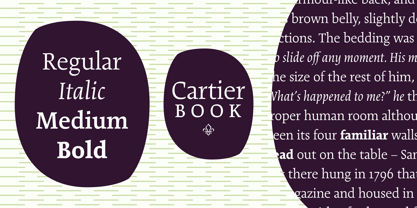Seleccione este tipo de licencia cuando esté desarrollando una aplicación app para iOS, Android o Windows Phone, y vaya a incrustar el archivo en el código de su aplicación móvil. va a incrustar el archivo fuente en el código de su aplicación móvil.
Cartier Book™
por Monotype
- Aa Glifos
-
¡Mejor PrecioPaquetes de familia
- Estilos individuales
- Especificaciones técnicas
- Licencias
Por estilo:
$73.99
Paquete de 4 estilos:
$295.99
Cartier Book Complete Family Pack
4 fuentesPor estilo:
$70.24
Paquete de 4 estilos:
$280.99
Cartier Book Complete Family Pack
4 fuentesPor estilo:
$61.49
Paquete de 4 estilos:
$245.99
Sobre la familia Cartier Book Fuente
Cartier fue el primer tipo de letra romana de Canadá, creado en 1967 para celebrar el centenario del país. Su diseñador, Carl Dair, fue uno de los pioneros del diseño gráfico más célebres del país y un excelente diseñador, pero no tenía formación como diseñador tipográfico. Pasó un año en la fundición e imprenta Enschedé, en los Países Bajos, pero probablemente no fue suficiente para comprender todo lo que se necesitaba para crear un tipo de letra eficaz. También es posible que Dair pusiera en peligro su propio diseño al no permitir que se hicieran las modificaciones necesarias en sus dibujos de trabajo cuando se entregaron a Linotype para su producción. Cartier, a pesar de ser un estilo antiguo sorprendentemente original, nunca se convirtió en el influyente tipo de texto polivalente que podría haber sido. Un tipo de letra para pantalla derivado de él, Raleigh, tuvo más éxito. Rod McDonald se dio cuenta de que el diseño de Dair era sólido en su concepto, aunque no en su ejecución, y empezó a trabajar en una nueva versión digital en 1997. La familia final es una prueba convincente de que Cartier podría haber sido la cara de texto funcional que Dair quería originalmente.
Diseñadores: Carl Dair, Rod McDonald
Editorial: Monotype
Fundición: Monotype
Propietario del diseño: Monotype
MyFonts debut: 13 de octubre de 2005

Acerca de Monotype
La Biblioteca Monotype es una de las mayores y más completas colecciones de tipos de letra del mundo, con diseños originales de importancia histórica y una nueva gama de diseños contemporáneos y de moda fuentes. La Biblioteca Monotype incluye miles de clásicos atemporales, revivals artesanales y diseños originales de muchos de los diseñadores tipográficos y fundiciones más innovadores de la historia. Esta biblioteca distintiva y galardonada de primera calidad fuentes ofrece a marcas y diseñadores una selección amplia y fiable de tipos de letra para una tipografía expresiva en impresión y en pantalla. La página de la Fundición Premium puede consultarse aquí.
Seguir leyendo
Leer menos